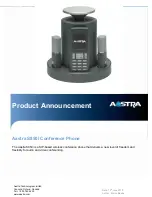
White Paper
T630/T628
16
October 2003
Sounds and melodies
EMS gives the user the ability to send and receive
melodies. These can be pre-defined sounds,
downloaded from the Internet, received in SMS
messages or composed by the user on the phone
keypad or a PC.
Several sounds and melodies can be inserted in
one message, and they can be combined with pic-
tures.
Pictures and animations
Phones supporting EMS include a set of pre-
defined animations. New pictures and animations
can be downloaded from the Internet or received in
SMS messages.
Pictures can be created and edited in the phone
using a built-in Picture Editor. Several pictures can
be inserted in one message, and they can be com-
bined with sounds and melodies.
Messaging using EMS
Concatenated messages
A part of the EMS standard is the support for con-
catenated messages, which means that the phone
is able to automatically combine several messages
both when creating and receiving EMS. This is use-
ful to be able to build and display messages with
rich content since the amount of information in
each SMS is limited by the SMS standards.
Compatible with SMS standards
Users will find EMS as easy to use as SMS. At the
moment 15 billion SMS messages, are sent every
month worldwide. Roughly 80% of this traffic is
user-to-user i.e. mobile phone users sending short
messages to each other using the keypad of the
phone to enter text. The remaining 20% is shared
by downloads and notifications of different kinds.
Huge business potential
Network operators can now enhance their services
and attract more customers by offering pictures,
animations, ring signals and melodies for download
at their portals. Operators can charge more per
EMS message since it contains more data. Thereby
EMS adds more value to the operators and to the
end users.
Standards
The Enhanced Messaging Service (EMS) was first
submitted to the standards committees by Erics-
son. Ericsson presented the outline structure of
EMS to the relevant ETSI/ 3GPP committees. The
major mobile phone manufacturers and most oper-
ators are actively contributing to the 3GPP stand-
ards. Hence the EMS standard has evolved and is
now stable and complete as part of the 3rd Gener-
ation Partnership Project (3GPP) technical specifi-
cation.
EMS dynamics
An EMS message can be sent to a mobile phone
that does not support EMS, or only supports part
of EMS. All the EMS elements i.e. text formatting,
pictures, animations and sounds are located in the
message header. The EMS contents will be ignored
by a receiving phone that does not support the
standard. Only the text message will be displayed
to the receiver. This is true consumer-friendly
standardization.
Examples of EMS contents and
applications
A wide range of contents, applications and serv-
ices may be developed. Below is a list of examples
and areas where messaging can be enhanced with
EMS.
User-to-user message
Messages usually originating from the keypad of a
mobile phone can include pictures, animations,
melodies, formatted text with EMS.
Voice and e-mail notifications
Notifying mobile phone users that they have new
voice or fax mail messages waiting - including
icons or melodies with EMS.
Содержание T628
Страница 1: ...October 2003 T630 T628 ...
















































